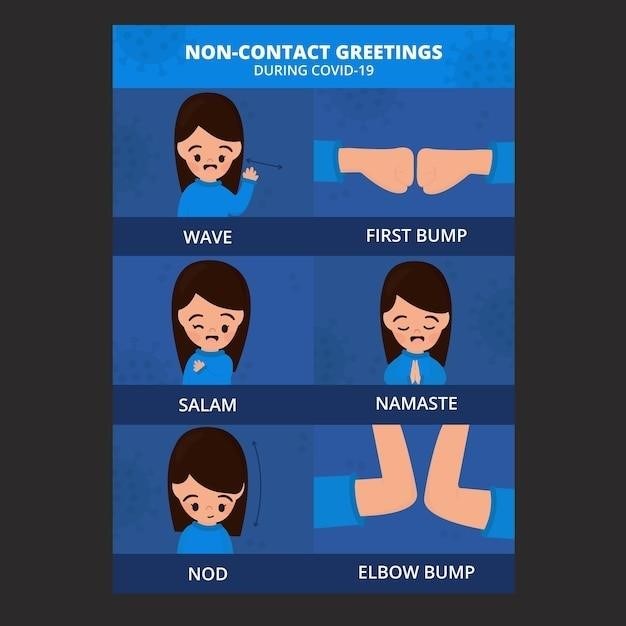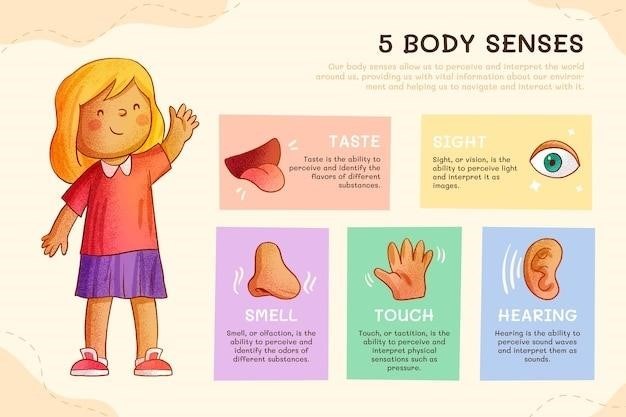Body Parts in Spanish and English⁚ A Comprehensive Guide
This comprehensive guide provides an in-depth exploration of body parts in Spanish‚ empowering you to confidently communicate about anatomy in this widely spoken language․ From basic vocabulary to idioms and resources‚ this guide equips you with the tools to expand your Spanish skills․

Introduction
Learning Spanish can be an enriching experience‚ opening doors to new cultures‚ travel opportunities‚ and personal growth․ Mastering the vocabulary of body parts in Spanish is a crucial stepping stone in this journey‚ as it allows you to engage in everyday conversations‚ understand medical scenarios‚ and even appreciate Spanish literature and media on a deeper level․
This guide aims to provide you with a comprehensive understanding of the Spanish words for various body parts‚ exploring their usage‚ pronunciation‚ and cultural nuances․ We’ll delve into common phrases and idioms related to body parts‚ helping you navigate conversations with confidence․ Whether you’re a beginner or an intermediate Spanish learner‚ this guide will equip you with the knowledge and resources to confidently communicate about the human body in Spanish․
Join us as we embark on this exciting exploration of body parts in Spanish‚ unlocking a new dimension of communication and cultural understanding․
Benefits of Learning Body Parts in Spanish
Learning body parts in Spanish goes beyond simply expanding your vocabulary; it unlocks a world of benefits‚ empowering you to communicate more effectively‚ connect with Spanish speakers on a deeper level‚ and even navigate medical situations with confidence․ Here are some key advantages⁚
Enhanced Communication⁚ Knowing the Spanish words for body parts allows you to participate in everyday conversations about health‚ appearance‚ and physical activities․ You can describe your own body‚ understand what others are referring to‚ and engage in more natural and fluent interactions․
Cultural Understanding⁚ The Spanish language often incorporates idioms and expressions that reference body parts‚ adding a layer of cultural richness to communication․ By understanding these phrases‚ you gain a deeper appreciation for the nuances of the Spanish language and culture․
Medical Preparedness⁚ In medical situations‚ being able to communicate clearly about your symptoms or needs is essential․ Knowing body parts in Spanish can help you describe your pain‚ explain your medical history‚ and receive accurate treatment․
Improved Spanish Skills⁚ Regularly practicing body part vocabulary strengthens your overall Spanish skills․ It improves your pronunciation‚ expands your word knowledge‚ and helps you grasp grammatical structures related to possession and description․
Learning body parts in Spanish is an investment in your language learning journey‚ opening doors to greater communication‚ cultural understanding‚ and personal growth․
Common Body Parts in Spanish and English
Mastering the vocabulary of body parts in Spanish is fundamental for effective communication․ This section presents a comprehensive list of common body parts in both Spanish and English‚ providing you with the essential building blocks for discussing anatomy in this language․
Here are some of the most frequently used body parts in Spanish‚ along with their English translations⁚
- Head⁚ Cabeza
- Face⁚ Cara
- Hair⁚ Pelo
- Forehead⁚ Frente
- Eye⁚ Ojo
- Ear⁚ Oreja
- Nose⁚ Nariz
- Mouth⁚ Boca
- Teeth⁚ Dientes
- Tongue⁚ Lengua
- Neck⁚ Cuello
- Shoulder⁚ Hombro
- Arm⁚ Brazo
- Hand⁚ Mano
- Finger⁚ Dedo
- Leg⁚ Pierna
- Foot⁚ Pie
- Toe⁚ Dedo del pie
These are just a few of the many body parts you’ll encounter in Spanish․ As you continue your language journey‚ be sure to expand your vocabulary and practice using these words in different contexts․ Remember‚ the more you practice‚ the more confident you’ll become in discussing the human body in Spanish․
Using Body Parts in Spanish Sentences
Once you’ve familiarized yourself with the vocabulary of body parts in Spanish‚ it’s time to put those words into action by forming sentences․ This section provides guidance on how to use body parts in Spanish sentences‚ ensuring you can express yourself clearly and accurately about anatomy․
One key aspect of Spanish grammar that applies to body parts is the use of definite articles․ In Spanish‚ we often use definite articles (el‚ la‚ los‚ las) before body parts‚ even when referring to our own body․ For example‚ instead of saying “My head hurts‚” you would say “Me duele la cabeza” (literally‚ “My head hurts”)․
Furthermore‚ when referring to someone else’s body parts‚ it’s common to use the preposition de (of)․ For example‚ “The eyes of Pedro” would be translated as “Los ojos de Pedro․” This structure emphasizes that the body part belongs to a specific person․
Finally‚ remember that Spanish verb conjugations are essential for accurate sentence construction․ Ensure you use the correct verb form based on the subject and tense of your sentence․ With practice‚ you’ll become proficient in using body parts in Spanish sentences‚ allowing you to communicate effectively about anatomy in this vibrant language․
Idioms and Expressions Related to Body Parts
Beyond their literal meanings‚ body parts in Spanish often feature in colorful idioms and expressions that add depth and nuance to the language․ Understanding these idioms can enhance your comprehension of Spanish culture and provide insights into how Spanish speakers use language creatively․
One common idiom is “tener la cabeza en las nubes” (to have one’s head in the clouds)‚ which signifies being daydreamy or absentminded․ Another is “estar de cabeza” (to be head over heels)‚ expressing intense love or infatuation․ These idioms showcase how body parts can be used figuratively to convey abstract concepts․
Additionally‚ expressions like “ponerse las pilas” (to put on the batteries) emphasize the importance of being energetic and proactive․ This idiom uses the image of batteries to depict a person’s motivation and enthusiasm․
Exploring these idioms and expressions can enrich your understanding of Spanish language and culture․ By incorporating them into your vocabulary‚ you can engage in more nuanced and expressive conversations‚ demonstrating a deeper appreciation for the intricacies of the Spanish language․
Resources for Learning Body Parts in Spanish
Mastering body parts in Spanish requires a multifaceted approach that leverages various resources․ You can access a wealth of information online‚ including interactive websites‚ flashcards‚ and printable worksheets․ These resources cater to diverse learning styles and preferences‚ ensuring an engaging and effective learning experience․
Interactive websites like “Spanish for English Speakers” offer beginner to advanced grammar‚ reading‚ and vocabulary exercises․ These platforms provide valuable tools for practicing body part vocabulary through engaging activities and quizzes․ Printable worksheets and flashcards‚ readily available online‚ offer a convenient way to reinforce your learning through spaced repetition and visual association․
Furthermore‚ consider exploring Spanish language learning apps that incorporate body part vocabulary into their lessons․ These apps often feature interactive games‚ quizzes‚ and audio recordings that facilitate both vocabulary acquisition and pronunciation practice․
By utilizing these resources‚ you can supplement your learning efforts and create a personalized study plan that aligns with your individual needs and preferences․ This comprehensive approach will empower you to confidently communicate about body parts in Spanish‚ enhancing your fluency and cultural understanding․
Printable Worksheets and Flashcards
Printable worksheets and flashcards provide a tangible and engaging way to learn and reinforce body part vocabulary in Spanish․ These resources offer a variety of exercises and activities designed to enhance comprehension and retention․
Worksheets often include fill-in-the-blank exercises‚ matching activities‚ and word searches‚ all focused on body parts․ This hands-on approach allows learners to actively engage with the vocabulary and solidify their understanding․ Flashcards‚ on the other hand‚ offer a visual and interactive method of learning․ They typically feature a picture of a body part on one side and the Spanish word on the other․
The use of flashcards facilitates spaced repetition‚ a proven learning technique that involves revisiting information at increasing intervals․ This method helps to strengthen memory recall and solidify vocabulary acquisition․ Moreover‚ flashcards can be used for various activities‚ such as matching games‚ memory exercises‚ and even creating personalized dictionaries․
Whether you prefer the structured format of worksheets or the visual appeal of flashcards‚ these resources provide valuable tools for mastering body part vocabulary in Spanish․ They cater to diverse learning styles and offer a fun and effective way to enhance your language learning journey․
Spanish Songs and Games for Learning Body Parts
Learning body parts in Spanish can be a fun and engaging experience‚ especially when incorporating songs and games into the process․ These interactive methods transform vocabulary acquisition into a playful activity‚ making it more enjoyable and memorable․
Spanish songs about body parts often feature catchy melodies and simple lyrics that are easy to learn․ The repetition of words and phrases reinforces vocabulary and helps learners associate the Spanish terms with their corresponding body parts․ Popular nursery rhymes like “Si estás feliz” (If you’re happy and you know it) offer a familiar framework for learning body parts in Spanish․ These songs are often accompanied by actions‚ further engaging learners and making the experience more interactive․
Games are another effective way to learn body parts in Spanish․ Simple games like “Simon Says” can be adapted to include Spanish vocabulary․ For example‚ “Simon says‚ ‘Toca tu nariz'” (Simon says‚ ‘Touch your nose’) encourages learners to identify and touch the designated body part․ Other games like “Bingo” can be used with body part vocabulary‚ allowing players to match images or words with their corresponding counterparts on their cards․ These games foster a competitive spirit while reinforcing vocabulary․
By incorporating songs and games into your learning routine‚ you can make mastering body parts in Spanish a fun and engaging experience․ These interactive methods not only enhance vocabulary acquisition but also create positive associations with the language‚ making it a more enjoyable and rewarding process․
Mastering body parts in Spanish is not merely about memorizing words; it’s about gaining a deeper understanding of the human body and its functions within the context of the Spanish language․ This knowledge opens doors to richer communication‚ enhanced cultural understanding‚ and a greater appreciation for the nuances of the Spanish language․ Whether you’re a healthcare professional‚ a traveler‚ or simply someone eager to expand their linguistic horizons‚ acquiring vocabulary related to body parts is an essential step towards fluency and cultural competency․
Remember that learning a language is a journey‚ not a destination․ Embrace the process‚ be patient with yourself‚ and find joy in the discoveries along the way․ Through consistent practice‚ engaging resources‚ and a willingness to explore the intricacies of the Spanish language‚ you’ll find that mastering body parts in Spanish is both rewarding and empowering․
The resources provided in this guide offer a solid foundation for your journey․ Utilize flashcards‚ printable worksheets‚ interactive quizzes‚ and engaging songs and games to reinforce your learning․ Don’t be afraid to seek out opportunities to interact with native Spanish speakers‚ as real-life conversations offer invaluable practice and insight into the language’s natural rhythm and flow․ As you delve deeper into the world of Spanish body parts‚ you’ll find that the rewards are both enriching and empowering․
References
“Body Parts in Spanish⁚ A Comprehensive Guide․” Spanish Academy‚ 29 Jul․ 2016‚ https://www․spanish․academy/blog/body-parts-in-spanish․
“Body Parts in Spanish ⎼ Free Printable Worksheet․” Spanish Academy‚ 29 Jul․ 2016‚ https://www․spanish․academy/blog/body-parts-in-spanish-free-printable-worksheet․
“Parts of the Body in Spanish․” Spanish Academy‚ 7 May 2018‚ https://www․spanish․academy/blog/parts-of-the-body-in-spanish․
“Spanish Body Parts Worksheets ⎻ el cuerpo humano․” Spanish Academy‚ 7 May 2018‚ https://www․spanish․academy/blog/spanish-body-parts-worksheets-el-cuerpo-humano․
“Body Parts in Spanish for Kids⁚ Learn the Spanish Words for Parts of the Body․” Spanish Academy‚ 7 May 2018‚ https://www․spanish․academy/blog/body-parts-in-spanish-for-kids-learn-the-spanish-words-for-parts-of-the-body․
“Anatomy in Spanish ⎻ The Body․” Spanish Academy‚ 7 May 2018‚ https://www․spanish․academy/blog/anatomy-in-spanish-the-body․
“Spanish Body Parts Flashcards․” Spanish Academy‚ 7 May 2018‚ https://www․spanish․academy/blog/spanish-body-parts-flashcards․
